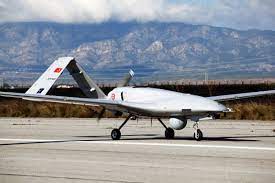The announcement comes as Moscow celebrated the Russian Day of Air Defense Forces on April 9. The number of drones sent by Turkey is significantly less than the Russian estimate, as Ankara had earlier publicly acknowledged the delivery of just 50 such drones to Kyiv.
When the Turkish Bayraktar TB2 drones were first deployed by Ukraine in combat last summer, they emerged as a weapon system that could change the course of the war in Kyiv’s favor. In the initial few weeks, they enjoyed the element of surprise and proved instrumental in some high-end missions.
For instance, the TB2 drones were believed to have aided the sinking of the Russian flagship Moskva, among other successful counter-missions carried out by the Armed Forces of Ukraine (AFU).Several videos showing Ukrainian drones obliterating Russian advances were widely shared on social media, attesting to their success.
However, Moscow’s air defense units are believed to have soon adapted to the Turkish weapon system. Russia, on its part, has been making claims about decimating the Turkish drones for the past several months.
In December 2022, Russian reports claimed that the Russian armed forces had shot down at least 130 Ukrainian drones since the conflict began.
As per the latest assertions made by the commander of the Air Defense Force, the figures have been revised and even downsized since December. The number of TB2 drones received by Ukraine and those lost in combat could not be corroborated.
The latest Russian claims, however, are significant. While announcing the number of Turkish drones shot down, the commander also referred to US drones to highlight the prowess of Russia’s air defense systems.
“There are practically no fundamental distinctions between fighting against strategic drones like the US Global Hawk (RQ-4) or Reaper (MQ-9) or Turkey’s operational-tactical Bayraktar-TB and counteraction to crewed aircraft. The elimination of more than 100 Bayraktars, delivered to Ukraine during the whole period of the special military operation, is clear evidence of this,” Demin said in an interview with the Russian army daily Krasnaya Zvezda.
This is significant because a US MQ-9 Reaper drone went into the Black Sea after an encounter with the Russian Su-27 fighter jet last month, triggering escalation concerns. Demin said the incident “makes it clear to the Western world community that for Russia’s air defenses, such aerial targets are no problem.”
Just days after the US drone went down, a similar incident was reported involving the Turkish TB2 drone. EurAsian Times reported a Turkish Bayraktar TB2 drone was attacked by a Su-27 Flanker using jet wash. However, the Turkish drone did not lose control and survived, unlike the Reaper.
Turkish Bayraktar TB2 Drones Disappeared
In late 2022, Russian media outlets highlighted the lack of the latest information regarding Bayraktar TB2’s combat operations in Ukraine since mid-August. These reports also noted that the Turkish drone operations have not been as successful as in Libya, Syria, and especially during the Nagorno-Karabakh war.
One of the last major encounters involving the Turkish drones was the assault on Snake Island, which began in the first weeks of May and lasted until the end of June. Many observers believed that Russia had improved the effectiveness of its layered air defense system after learning from its blunders during this period.
One of the reasons Turkish drones might be less successful is that Russia has bolstered its defense systems and is shooting down and jamming many drones from Ukraine.
Samuel Bendett, an analyst and expert in unmanned and autonomous military systems, noted that Russian electronic warfare and air defenses improved coordination and deployment after significant battlefield blows dealt by Ukraine with the help of TB2 drones.
The expert explained that a drone’s location is determined by early warning radars employed by Russian forces. Their transmission is interfered with and jammed using electronic warfare weapons. Besides that, Moscow also uses a variety of weapons, including machine guns and air defense systems, like the Tor missile system, to shoot drones.
Russia has been relentlessly working to advance its air defense technology for better effectiveness. For instance, the military has deployed the state-of-the-art Niobium radar station on the frontlines, which scans the sky within a radius of 500 kilometers while simultaneously tracking hundreds of objects or potential targets.
Having said that, after TB2’s combat success in Ukraine, Turkey announced it wanted to establish a drone factory in Ukraine. Later, it backed out, giving rise to speculations that Russia’s lethal air defense systems shooting down AFUs might have influenced the decision.
However, Russian media finally noted that political machinations between Russia and Turkey, rather than Russian air defense systems, are to blame for the absence of Turkish drones.

